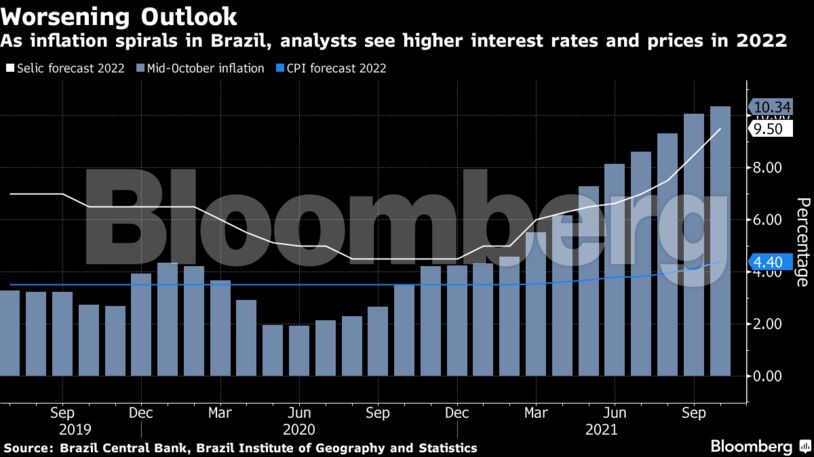“Recent questioning regarding the fiscal framework increased the risk of deanchoring inflation expectations,” they wrote. “This implies a higher probability of inflation paths above the one projected under the baseline scenario.”

Policy makers led by Roberto Campos Neto have been the most hawkish in the world this year, raising the benchmark rate by 575 basis points since March. While the central bank had signaled as recently as Oct. 14 that the Selic rate would be increased by a full percentage point at this meeting, President Jair Bolsonaro’s proposal to boost spending beyond a key austerity rule led the bank to speed up its monetary tightening campaign.
While local markets were closed when the bank’s decision was announced, a Japanese exchange-traded fund tracking Brazil’s main stock gauge fell 0.6%, heading for its lowest close since late April.
Read More: Central Banker Stands Alone With Brazil’s Credibility Crumbling
What Bloomberg Economics Says
“Brazil’s central bank accelerated the pace of rate hikes, pledged another large increase in December and indicated that monetary policy will end the cycle tighter than previously anticipated. But the key questions — what the BCB thinks of proposed fiscal changes and what they mean for neutral rates — remain unanswered.”
— Adriana Dupita, Latin America economist
Click here to read the full report.
In the statement, policy makers wrote the pace of consumer price increases remains high and that there’s additional pressure on core inflation. In such a scenario, it’s appropriate to implement an even more restrictive monetary policy, they added.
“The central bank raised the balance of risks,” said Tatiana Nogueira, an economist at XP Inc. “This implies a greater probability of inflation running higher than the baseline outlook.”
Even Tougher
Other economists said the bank may need to turn even more hawkish to prove its inflation-fighting credentials. In the statement, policy makers wrote their policy horizon focuses on bringing inflation to target in 2022 and 2023.
“The central bank should have come out with an even tougher message,” said Carlos Kawall, director at Asa Investments. “It could have taken a risk and delivered a bigger rate increase. The inflation outlook is very ugly.”
The rate hike is likely to have an impact in sectors that greatly benefited from a recent period of low borrowing costs, including real estate and the equity market, on top of boosting Brazil’s debt service burden. It’s also likely to slow down activity further at a time some economists warn about the growing risk of recession next year.
It’s not guaranteed to boost the real, however. The currency weakened more than 3% last week, adding pressure on inflation, as investors digested the proposed changes to the so-called spending cap — a rule that limits growth of the federal budget to the previous year’s inflation rate.
Double-Digit Rate
The last time policy makers delivered an increase of more than 100 basis points to the Selic was in late 2002, when markets panicked as Luiz Inacio Lula da Silva was about to assume the presidency.
Now, as investors wait for lawmakers decide on whether they will increase the amount of public expenditures that’s exempt from the spending cap, market inflation expectations are running above target through 2024.
Consumer prices rose 1.2% in mid-October, more than all forecasts in a Bloomberg survey and the highest for the month since 1995. Annual inflation surged to 10.34%, according to government data published on Tuesday. Policy makers target inflation at 3.75% this year and 3.5% in 2022.
“Today’s move is a decisive step in the right direction and much needed amidst the perceived erosion of the fiscal anchor,” said Alberto Ramos, chief Latin America economist at Goldman Sachs Group Inc. “But unfortunately more is likely needed. Get ready for a double-digit Selic in 2022.”





Comments - Please login in order to comment.